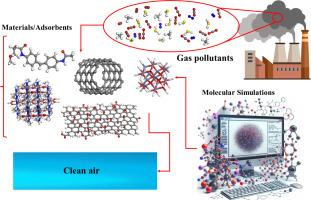分子模拟:从基本原理到气体污染物控制的应用
IF 8
1区 环境科学与生态学
Q1 ENVIRONMENTAL SCIENCES
引用次数: 0
摘要
从环境中清除气态污染物对于减轻空气污染和保障公众健康至关重要。传统的气体污染物去除实验室方法面临着重大挑战,包括复杂的实验设置,有限的可扩展性,以及在现实条件下难以捕获分子水平的相互作用。分子模拟已经成为解决这些问题的有力工具,目前的研究重点是提高计算效率和力场精度,以模拟不同的污染物和材料。这些方法预测了气体污染物的吸收特性,提供了在分子水平上的详细见解,这在实验上是具有挑战性的。本研究首先讨论了分子模拟方法的理论基础,强调了它们在理解气固相互作用方面的相关性。分析了各种吸收剂的物理和化学性质,重点介绍了它们在捕获和中和有害气体方面的有效性。该研究还研究了分子模拟在确定关键转移特性(如渗透性、溶解度和选择性)方面的影响,这些特性可以增强吸收材料的设计和优化。这项研究的重要性在于它有可能预测气体污染物的去除效率,为制定有效的污染控制策略提供有价值的工具。这种方法促进了对气体吸收机制的理解,并深刻影响了环境保护创新解决方案的发展。通过回顾过去的成就、目前的应用和未来的方向,本文强调了分子模拟在加速开发有效控制气体污染物的新型材料方面的变革作用。本文章由计算机程序翻译,如有差异,请以英文原文为准。

Molecular simulations: From fundamental principles to applications in gaseous pollutant control
Removing gaseous pollutants from the environment is crucial for mitigating air pollution and safeguarding public health. Conventional laboratory methods for gaseous pollutant removal face significant challenges, including complex experimental setups, limited scalability, and difficulties in capturing molecular-level interactions under real-world conditions. Molecular simulations have emerged as a powerful tool to address these issues, with ongoing research focusing on improving computational efficiency and force field accuracy to model diverse pollutants and materials. These methods predict the absorption properties of gaseous pollutants, offering detailed insights at the molecular level that are challenging to achieve experimentally. This research begins by discussing the theory underlying molecular simulation methods, highlighting their relevance in understanding gas-solid interactions. Various absorbents' physical and chemical properties are analyzed, focusing on their effectiveness in trapping and neutralizing harmful gases. The study also examines the influence of molecular simulations in determining key transfer properties, such as permeability, solubility, and selectivity, which enhance the design and optimization of absorbent materials. The importance of this research lies in its potential to predict the removal efficiency of gaseous pollutants, providing valuable tools for developing effective pollution control strategies. This approach advances the understanding of gas absorption mechanisms and profoundly impacts the development of innovative solutions for environmental protection. By reviewing past achievements, present applications, and future directions, this article underscores the transformative role of molecular simulations in accelerating the development of novel materials for efficient gaseous pollutant control.
求助全文
通过发布文献求助,成功后即可免费获取论文全文。
去求助
来源期刊

Science of the Total Environment
环境科学-环境科学
CiteScore
17.60
自引率
10.20%
发文量
8726
审稿时长
2.4 months
期刊介绍:
The Science of the Total Environment is an international journal dedicated to scientific research on the environment and its interaction with humanity. It covers a wide range of disciplines and seeks to publish innovative, hypothesis-driven, and impactful research that explores the entire environment, including the atmosphere, lithosphere, hydrosphere, biosphere, and anthroposphere.
The journal's updated Aims & Scope emphasizes the importance of interdisciplinary environmental research with broad impact. Priority is given to studies that advance fundamental understanding and explore the interconnectedness of multiple environmental spheres. Field studies are preferred, while laboratory experiments must demonstrate significant methodological advancements or mechanistic insights with direct relevance to the environment.
 求助内容:
求助内容: 应助结果提醒方式:
应助结果提醒方式:


